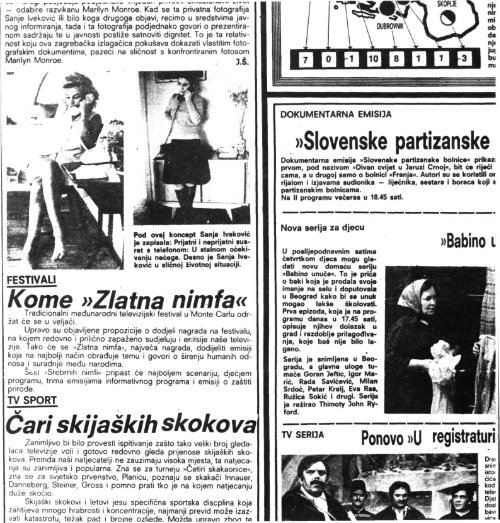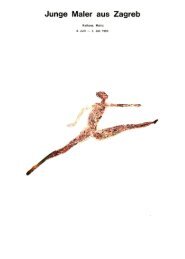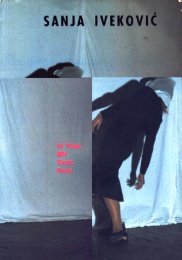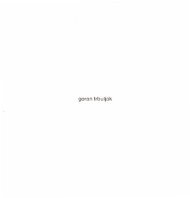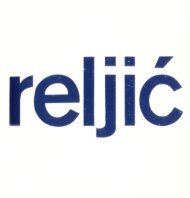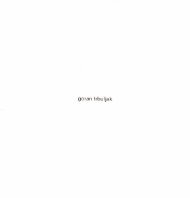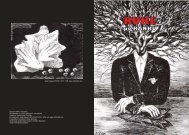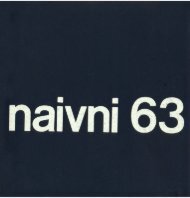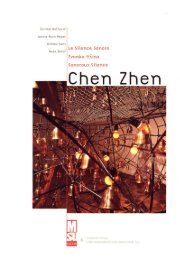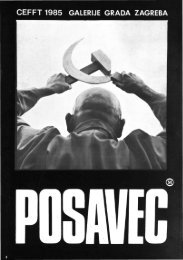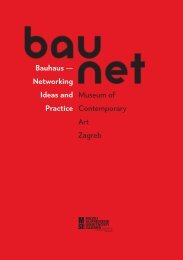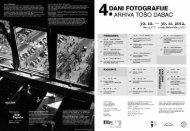SANJA IVEKOVIÄ_DOKUMENTI (1949-1976).pdf - Muzej ...
SANJA IVEKOVIÄ_DOKUMENTI (1949-1976).pdf - Muzej ...
SANJA IVEKOVIÄ_DOKUMENTI (1949-1976).pdf - Muzej ...
Create successful ePaper yourself
Turn your PDF publications into a flip-book with our unique Google optimized e-Paper software.
sanja ivekovic<br />
DOKUMENT1<strong>1949</strong>-<strong>1976</strong><br />
galerija suvremene umjetnosti<br />
zagreb<br />
10.-30.12.<strong>1976</strong>.
Tomoljnjtm obilježjima ovog vremena, a odati* I aktualnoj umjetnosti,<br />
treba priključiti zaokupljenost medijima. Posredno sagledavanje<br />
svijeta, što ga mediji omogućuju alt I nameću, postalo je jedno od<br />
osnovnih mjerila zbivanja I značenja na najrozličitljim nivoima aktualnoga<br />
urbanog života I u relativno malim sredinama poput nale.<br />
Štoviše, medijem Interpretirani svijet postao je prihvaćena realnost.<br />
Stoga već dva desetljeća postoji intenzivno povratno djelovanje unutar<br />
umjetnosti, naime, taj umjetno stvoreni prvenstveno urbani okolii<br />
(rektoma, štampo, televizija I druga sredstva) formira specifičnu Ikonografiju<br />
potrošačkog društva, koja se reflektira u slikarstvu popartom<br />
u početku, a kasnije u netto posrednijem načinu kao sto je<br />
hiperrealizam, te paralelno I specifičnim oblicima izražavanja filmom<br />
i videom kao sredstvima plastičkog prikazivanja a ne samo medijima<br />
umjetnika sineasta.<br />
U tom kontekstu nastao je aktualni rod Sanje Iveković, koja je nakon<br />
zajedničkih iskustava stečenih na intervencijama u urbanom prostoru<br />
ostala vezana za podruitvovljeni oblik vtzuelnih komunikacija.<br />
Radeći reprografiku prvenstveno primjenjenu televiziji, Sanja Iveković<br />
je nastavila autorski rod u dodirima s video-tapeom, obrodjujući<br />
teme medijske (televizijske) realnosti. Paralelno s tim, zamišljena je<br />
i prikupljena ova cjelina materijala pod nazivom "Dokumenti <strong>1949</strong> -<br />
<strong>1976</strong>", no temu autor - medijska okolina, odnosno identltetontiidentitet.<br />
Ona sadrži manifestiranje osobnosti pojedinca (autorice)<br />
u sukobu s otudjujućim utjecajem masovnih medija (štampe plasirane<br />
u ovoj sredini).<br />
Izložene su reprodukcije izrezane iz fotoreportaža, reklamnih prizora,<br />
novela, iz prikaza ličnosti i dogodjaja kriminalističkog žanra iz u-<br />
puta za upotrebu kozmetike i njegu tijela s pripadajućim tekstovima<br />
(potpisima ispod slika). Uz njih su u parovima smještene i fotografije<br />
iz vlasništva autorice s prikazima njenoga obiteljskog ? osobnog života,<br />
odabrane a ne posebno snimane, tako da zajedno s prvima tvore<br />
novu smisaonu cjelinu. S jedne strane autorica je odabrala dokumente<br />
medijem predimenzioniranog "svijeta žene", koji nosi obilježja<br />
glamour fotografija, poziranih "slučajnosti svakidašnjice", dramatičnih<br />
i melodromatičnih ili sasvim neutralnih scena. Fotosi s druge<br />
strane odabrani su kao dokument o načinu autoričina života, na razini<br />
privatnih uspomena o izgledu i ponašanju u nedavnoj prošlosti.<br />
Tako serijo "Dvostruki život" u klišetiziranim odnosno masovnim i<br />
autentičnim, individualnim, scenama unutar formiranih parova sadrži<br />
analogije uzrokovane različitim nivoom i tipom pristupa od izgleda<br />
preko ponašanja do situacija, potencirane sugestivno-propagandnim<br />
tekstovima i privatnim bilješkama. Fotografije beznačajnih ličnosti u<br />
značajnim situacijama njihova života te fotografije značajnih ličnosti<br />
u beznačajnim situacijama proširuju svoje djelovanje i na autoričine<br />
fotose odgovarajućeg sadržaja, zajedno prezentirane - u serijama<br />
"Gorki život" i "Slatki život". Ironizirajući je usporedila vlastiti<br />
život s melodromatično interpretiranim životnim tokom Merilin<br />
Monroe, u rodu "Tragedija jedne Venere", gdje je pokazala da je<br />
afirmacija "zvijezde", pa tako i umjetnice, dio propagandnog "storsistema".<br />
U radovimo organiziranim u grupe, albume i križaljke suprotstavljeni<br />
su fotosi konkretnih, ličnosti koje time dobivaju opća značenja medjusobno<br />
zavisnih I Isprepletenih razina. Tako se tema sukoba realnog I<br />
idealiziranog očituje od nivoa izgleda (u usporedjenjima predložaka<br />
za i ostataka nakon upotrebe moke-upa, u rodu "Dnevnik"), preko<br />
nivoa kompleksnih životnih problema (u Ilustriranju perfidno smišljenih<br />
reklamo koje utječu na psihu čitaoca-potrošača, u radu "Osam<br />
The preocuupation with the media hos become one of the basic characteristics<br />
of our age and, consequently, of contemporary art. The<br />
Indirect experience of the world the media have not only made pcesfble,<br />
but imposed upon us, has become one of the basic criteria of<br />
the developments at various levels of modern urban life even in comparatively<br />
small communities such as ours. What is more, the world<br />
interpreted through the medium has become the accepted reality. For<br />
the past twenty years there has been an Intensive feedback actio in<br />
art: the artificially created, primarily urban, environment (advertising,<br />
the press, television and other media) has molded a specific<br />
iconography in the consumer society, which was initially reflected In<br />
painting as popart and later In more indirect ways such as hyperrealism,<br />
and, at the same time, in specific ways of expression in<br />
film and videotape, used as tools in visual art and not only as cinematographic<br />
media.<br />
This Is the context in which we must place actual work of Sanja<br />
Iveković. After common experience on urban interventions, she has<br />
maintained her interest in the socialized forms of visual communication.<br />
Her main preoccupations have been the videotape and themes<br />
of television reality. The present exhibition, entitled "Documents<br />
<strong>1949</strong> - <strong>1976</strong>", deals with the artist herself and the medium environment,<br />
i.e. with identity and anti-identity. It contains manifestatlonsof<br />
the special characteristics of the individual (the artist) on conflict<br />
with the alienating influence of.mass media (the press). It<br />
shows reproductions clipped from newspaper photographs, advertisements,<br />
short stories, descriptions and events from detective stories and<br />
instructions and illustrations for the use of beauty products. Alongside<br />
these there are pairs of photographs of the artist depicting her<br />
family life which have been selected in such a way as to form a<br />
meaningful whole with the rest of the medium-inflated "woman's<br />
world" with all its characteristics of glamour photographs, poses of<br />
"everyday scenes", some dramatic, some melodramatic or quite neutral.<br />
The photographs, on the other hand, have been chosen as<br />
documents on the artist's way of life, and take the form of private<br />
memories of events from her recent past.<br />
The series "Double Life" contrasts pairs of scenes from mass media<br />
and individual scenes with analogies brought about by the different<br />
level and type of approach ranging from behaviour to situations,<br />
underlined by advertisements and private notes. The meaning of the<br />
photographs of unimportant personalities in the most significant<br />
situations of their lives and photographs of well-known personalities<br />
in trivial situations reflects onto authentic photographs of the some<br />
content, which are presented in the series "Bitter Life" and "Sweet<br />
Life". The artist compares In an ironical way her own life with a<br />
melodramatic interpretation of Marilyn Monroe's life In "The Tragedy<br />
of a Venus", In which"she shows that the affirmation of a "star" and<br />
that of an artist forms part of the commercialized "star system".<br />
Works organized in groups, albums and crossword puzzles contrast<br />
photographs of real-life personalities, thus giving them a general<br />
meaning of mutually dependent and linked levels. Thus the theme of<br />
the real and the idealized manifests itself from the level of appearance<br />
(in a comparison of samples before and after the use of makeup<br />
In "Diary"), over complex problems of life (In illustrations of<br />
cleverly designed advertisements that exert a powerful influence on<br />
the mind of the reader-consumer In "Eight Tears"), to the level of<br />
depicting real-life histories and dramas (by contrasting notices obout<br />
run-oway and missing girls with photos of pin-up girls In the "Black
suzo"), do nlvoo uočavtfnjo posebnih životnih tokova I drama (konfrontiranjem<br />
oglasa o odbjeglim I nestallm djevojčicama t fotoslmo<br />
pln-up gerlsa, u rodu "Crni fascikl"). Dvostrukim paralelama nekadoinjeg<br />
idealiziranog i danoinjeg realnog izgleda biviih ljepotica s<br />
banalnim usporednim uputama za uljepšavanje, pod nazivom "Prije -<br />
Poslije", autorica inicira veieslojna razmilijonja o slučajnim i općim<br />
pojavama različitog: povrinog I dubokog značenja jednih te istih simbola<br />
prezentiranih jezikom riječi i slika. U radu "Struktura" autorica<br />
varira u deset rodova, deset različitih fotosa žena, s pripadajućim<br />
tekstovima, tako da je svaka sukobila u kombinaciji sa svakim od<br />
napisa, a da se pri tom ni vizuelno ni značenjska ravnoteža nije poremetila.<br />
Tim je rodovima Sanja Iveković dovela do apsurda tipično<br />
medijske formulacije sadržaja, koje bez obzira na specifičnosti i karakter<br />
neke informacije sadrže toliko općenite formulacije da uvijek<br />
funkcioniraju opravdane same po sebi, ito potvrdjuje da istinitost<br />
informacije u njima ovisi o onome tko se medijem služi, odnosno u<br />
čijim je rukama. Provocirajući tako najdalekosežnija razmišljanja o<br />
društvenoj temi i odredjenju čitave izložbe, ona je jasno izrekla<br />
svoj kritički stav prema aktualnoj medijskoj okolini.<br />
Koristeći se paralelama, montažama, kolažima izgleda i značenja,<br />
odnosno poistovjećenjima, analogijama, kontrastima, uključenjima i<br />
sugestijama - Sanja Iveković je otkrila i na sebi svojstven način prezentirala<br />
i interpretirala lažne mitove i ideale, odnosno pseudopotrebe,<br />
koje se nameću publici mas-medijima kao rezultati vladaj ućih<br />
vrijednosti odnosno imperativi imaga i ponašanja. Kritički impostlran<br />
njen rod' napada situaciju kojom se u potrošačkom društvu na nov način<br />
padretrjuje žena i pretvara u predmet, lako je time zašla u sociološku<br />
problematiku, autorica se zadržala na vizualnoj prezentaciji I<br />
vizuelnim je "kriterijima" prtila ispitivanju etičkih "pojava". Ispitujući<br />
vlastitu osobu, ona je došla do nov»th oblika- prezentacije kao i<br />
otvorenosti na rubu nametljivosti i narcisoidnosti. Tako je vlastiti rad<br />
približila jednoj od aktualnih tema u kontinuitetu "elitne" kulture:<br />
temi "Umjetnik u prvom licu", gdje autor prezentira svoju ličnost u-<br />
mjesto proizvedenog djela neprimjetnog u konkurenciji jačih medija.<br />
Istodobno je, ispitujući medij štampe, uočila obilje specifičnih pojava<br />
medijske okoline. Time je kritički zašla u neke od dimenzija masovne<br />
kulture, prvenstveno u afimativnosti izgleda ali I negativnost<br />
površnosti, gdje je ukazala na formiranje mentaliteta, ne više<br />
provincijalno-malogrodjanskog nego svjetskog mediokritetskog tipa.<br />
U sukobu subjektivnog osobnog, koje je realno, I objektivnog (medijskog),<br />
koje je nerealno, dakle u Inverziji, stvorena je inovacija I<br />
napetost ove izložbe. Prepletom aktualnih tema, aktualnih načina<br />
monifestiranja i područja prezentiranja, Sanja Iveković je kritički načeta<br />
područje sukoba ličnosti i bezlfčja, pojedinca i mnoštva, Informacija<br />
i medija. Tako je otvorila vlastito područje prezentacije autorskih<br />
I općih problema koji više ne pripadaju tradicionalnom galerijskom<br />
tipu ali ne odgovaraju ni postojećim oblicima upotrebe masovnih<br />
medija gdje zo osobni, a pogotovo povratni, oblik komunikacije<br />
još nema mjesta.<br />
File". In her double parallels of the past Idealized and the present<br />
real look of former beauties and banal instructions for beauty care,<br />
entitled "Before - After", the artist initiates reflections on incidental<br />
and general phenomena of contrasts: the surface and deep meaning<br />
of the same symbols presented in the language of words and<br />
pictures. In "Structure" the artists presents a variation of ten photographs<br />
accompanied by ten captions, so that each photograph appears<br />
in combination with each of the captions without changing the<br />
visual balance or the balance of the meaning. In these works Sanja<br />
Iveković brings to the absurd formulations typical of mass media,<br />
which are so general as to always function, justified by themselves,<br />
thus showing that the truthfulness of the information in them depends<br />
on the person using the medium. rVovoking far-reaching thoughts<br />
about modern society, she has clearly expressed her critical attitude<br />
to the contemporary media-dominated life. Using parallels, montage<br />
of appearance and meaning, and by identifications, analogies,<br />
contrasts and suggestions , Sanja Iveković has disclosed and presented,<br />
in her own unmistakeable way, false myths and ideals or pseudoneeds<br />
imposed on the consumer by mass media - the result of accepted<br />
values and the imperatives of the accepted image and behaviour.<br />
Her work attacks the situation in which the consumer society enslaves<br />
the woman in a new way and turns her into an object,<br />
she has thus entered the field of sociological problems, the artist limits<br />
herself the visual presentation and uses visual criteria to examine ethical<br />
phenomena. Examining herself, she has reached new forms of presentation<br />
and openness on the edge of intrusiveness and narcissism. She has thereby<br />
approached one of the topical subjects In the continuity of "elite"<br />
culture: that of the "artist In the first person", where the artist presents<br />
her own personality instead of the produced work, inconspicuous<br />
in the competition of stronger media. Analyzing the press, she<br />
has identified a number of specific phenomena of the medium environment.<br />
She deals critically with a number of elements of moss culture:<br />
the dominance of the appearance, the negative character of<br />
superficiality, and points to the rise of a new mentality, which is<br />
no longer petit-bourgeois but a mentality of world-wide mediocrity.<br />
In the conflict between the subjective (personal), which-is real, and<br />
the objective (the medium), which is unreal, i. e. in inversion,<br />
lies the Innovation and tension of the present exhibition. By interlacing<br />
topical subjects, their contemporary manifestations and the region<br />
of their presentation, Sanja Iveković has adopted a critical approach<br />
to the field of conflict between the personal and the impersonal<br />
the individual and the mass, the information and the medium. She<br />
has thus opened her own field of presentation of individual and general<br />
problem, which are neither those that are traditionally found<br />
In galleries nor in the existing forms of mass media, where there is<br />
as yet no room for the personal, and even less for the feedback type<br />
of communication.<br />
Davor Matičević<br />
Davor Motlčevlć
OTVORENJE<br />
akcija /performance<br />
The Opening
The perverted "boss" of the gang used<br />
to black-mail young men.<br />
Nastrana »šefica« bando<br />
ucjenjivala |« mladiće:<br />
Srigšia P»<br />
GORKI ŽIVOT<br />
Bitter Life
With No. 1 is marked the place wher
SLATKI ŽIVOT<br />
Sweet Life<br />
UN MALE MISTEnlQSO
Nešto lakše
DNEVNIK<br />
Diary
PRIJE-POSLIJE<br />
Before-after
OSAM SUZA<br />
Eight Tears
CRNI FASCIKL<br />
The black File
er<br />
3 ff<br />
fes<br />
IS
KATALOG:<br />
1. OTVORENJE<br />
Akcijo Izvodono u hodniku galerije u 19 tati 10. 12. <strong>1976</strong>.<br />
Stetoskop, mikrofon, pojačalo ta zvučnicima, tra|anje 20 minula.<br />
2. DVOSTRUKI ŽIVOT, 1975.<br />
Ciklus od 62 para stranica, propagandni oglasi Iz modnih revija,<br />
datum tiskanja /Toto-dokumentl S. I., blljelke o vremenu nastanka,<br />
situaciji I osobama na foto-dokumentu, Iz razdoblja 1959-<br />
1975, kolor I crno-bljelo, 590 x420.<br />
3. GORKI ŽIVOT, 1975.<br />
Ciklus od 27 stranica, fotografijo s tumačenjima Iz "crnih kronika"<br />
revijalnog tiska /Foto-dokumentl S. I. iz razdoblja <strong>1949</strong>-<br />
1975, crno-bljelo, 210 x 295.<br />
4. SLATKI ŽIVOT, 1975/76.<br />
Ciklus od 21 stranice, fotografijo iz "skandaloznih rubrika" revijalnog<br />
tiska, foto-dokumenti S. I. Iz razdoblja 1969-<strong>1976</strong>, crnobijelo,<br />
290 x 350.<br />
5. TRAGEDIJA JEDNE VENERE, 1975.<br />
Ciklus od 20 parova stranica, foto-blograflja Merllin Monroe s<br />
tumačenjima iz revijalnog tiska /foto-dokumenti S. I. iz razdoblja<br />
<strong>1949</strong>-<strong>1976</strong>, cmo-bijelo, 420 x 295.<br />
6. OSAM SUZA, <strong>1976</strong>.<br />
Mapa od 8 stranica, 8 propagandnih oglasa Helena Rubinstein I<br />
8 fotografija iz revijalnog tiska, tekst: ljubav, brak, materinstvo,<br />
domaćinstvo, posao, starost, ego, kolor I crno-bljelo, 160 x 500.<br />
7. CRNI FASCIKL, <strong>1976</strong>.<br />
Mapa od 5 parova stranica, 5 fotografija Iz revijalnog tiska/5<br />
oglasa o izgubljenim osobama iz dnevnog tiska, kolor i cmobijelo,<br />
210 x 295.<br />
8. JUTARNJA SLIKA, VEČERNJA SLIKA, 1975/76.<br />
2 pastela, sjenilo, rumenilo za obraze, olovka za oči, ten,<br />
puder, ruž na papiru, 300 x 240.<br />
9. DNEVNIK, 1975/76.<br />
Ciklus od 7 slika, 7 propagandnih fotografija za meJce-up iz modnih<br />
revija /dnevni tragovi de-moquillagea S. I. na vati I ubrusima,<br />
datumi, kolor, 470 x 350.<br />
10. PRIJE-POSLIJE, 1975/76.<br />
Ciklus od 3 sliko, 3 para fotografija Iz dnevnog tiska I 3 para<br />
propagandnih fotografija iz revijalnog tiska, naslov, kolor i<br />
crno-bijelo, 470 x 350.<br />
11. IDENTITET/PRIJE-POSUJE/, 1975/76.<br />
Fotografija Merllin Monroe, propagandna fotografija, fotodokument<br />
S. I., crtež, kolor i crno-bljelo, 600 x 780.<br />
12. STRUKTURA, 1975/76.<br />
100 fotografija s tumačenjima, iz dnevnog tiska I revija, pano,<br />
crno-bijelo, 1500 x 2000.<br />
13. BIOGRAFIJA, <strong>1976</strong>.<br />
3 foto-porrrero S. I. , tekstovi umjetničke biografije S. I. Iz<br />
godina 1970, 1972, <strong>1976</strong>, crno-bljelo, 610 x 730.<br />
THE CATALOGUE<br />
1. THE OPENING<br />
The action was performed In the corridor of the Gallery at 19<br />
hours on December 12, <strong>1976</strong>. A stethoscope, a microphone, an<br />
amplifier with loudspeakers, duration 20 minutes.<br />
2. DOUBLE LIFE, 1975.<br />
A cycle of 62 pairs of pages, advertisements from fashion magazines,<br />
printing date /photo-documents S. I., notes on the time<br />
the/ were mode, the situation and the persons on the photodocuments<br />
dating from 1959-1975, colour and black and white,<br />
590 x 420.<br />
3. BITTER LIFE<br />
A cycle of 27 pages, photographs with captions from magazine<br />
"black chronicles" / photo-documents S. I. of <strong>1949</strong>-1975,black<br />
and white, 210 x 295.<br />
4. SWEET LIFE, 1975/76.<br />
A cycle of 21 pages, photographs from magazine "scandal columns",<br />
photo-documents S. I. of 1969-<strong>1976</strong>, black and white,<br />
290 x 350.<br />
5. THE TRAGEDY OF A VENUS, 1975.<br />
A cycle of 20 pairs of pages, a photo-biography of Marilyn<br />
Monroe with captions of magazine extracts / photo-documents<br />
S. I. of <strong>1949</strong>-<strong>1976</strong>, black and white, 420 x 295.<br />
6. EIGHT TEARS, <strong>1976</strong><br />
File, 8 pages, 8 advertisements for Helena Rubinstein and 8<br />
magazine photographs, captions: love, marriage, motherhood,<br />
household, work, old age, the ego, colour and block and white,<br />
160 x 500.<br />
7. THE BLACK FILE, <strong>1976</strong>.<br />
File, 5 pairs of pages, 5 magazine photographs / 5 notices on<br />
lost persons from dailies, colour and black and white, 210 x 295.<br />
8. MORNING PICTURE, EVENING PICTURE, 1975,76.<br />
2 pastels, eye shadow, blush-on, eye pencil, foundation cream,<br />
powder, lipstick on paper, 300 x 240.<br />
9. DIARY, 1975/76.<br />
Cycle of 7 pictures, 7 photographs advertising make-up from<br />
fashion magazines / daily traces of make-up removal on cotton<br />
and napkins, dates, colour, 470 x 350.<br />
10. BEFORE-AFTER, 1975-76.<br />
Cycle of 3 pictures, 3 pairs of photographs from dailies and 3<br />
pairs of advertisement photographs from magazines, titles, colour<br />
and black and white, 470 x 350.<br />
11. IDENTITY/BEFORE-AFTER/, 1975/76.<br />
A photograph of Marilyn Monroe, advertisement photograph,<br />
photo-document S. I., drawing, colour and block and white,<br />
600 x 780.<br />
12. STRUCTURE, 1975/76.<br />
100 photographs with captions, from dallies and magazines, board,<br />
black and white, 1500 x 2000.<br />
13. BIOGRAPHY, <strong>1976</strong>.<br />
3 photo portraits of S. I., texts of S. I. s artistic biography of
Sonja<br />
Ivekovic<br />
Rodjena 6. 1 . <strong>1949</strong>. u Zagrebu. Na Akademiji likovnih umjetnosti u Zagrebu diplomirala 1970.<br />
Born 6. 1. <strong>1949</strong> in Zagreb. Graduated 1970 from Academy of Fine Arts in Zagreb.<br />
Samostalne<br />
izložbe:<br />
1970-Galerija Studentskog centra, Zagreb<br />
IFSK, Zagreb<br />
1973. "TV-timer", video-akcija /s D. Martinisom/, Trigon, Graz<br />
<strong>1976</strong>. "Un jour violente", performance, Galleria del Cavallino, Arte Fiera, Bologna<br />
"Un jour secrete", akcija, Galleria del Cavallino, <strong>Muzej</strong> Pozin, Galeria suvremene<br />
umjetnosti, Motovun<br />
Video, /s D. Mortinisom i G. Trbuljakom/, Referalni centar, Zagreb<br />
"Otvorenje", akcija, Galerija suvremene umjetnosti, Zagreb<br />
Kolektivne<br />
izložbe:<br />
1971. Mogućnosti, Galerija suvremene umjetnosti, Zagreb<br />
7. bienale mladih, Park Floral, Paris<br />
Trigon 71, Graz<br />
Guliver, Galerija Studentskog centra, Karlovac<br />
1973. Trigon 73, Graz<br />
Sterijino pozorje, Novi Sad<br />
1974. Joi jedna prilika, Galerija Studentskog centra, Zagreb<br />
Projekcija dijapozitiva umjetnika, Galerija Stanara, Balkan kino Zagreb<br />
Galerie des locataires, Milano<br />
Impact-art-video-art, Lausanne, Bruxelles<br />
1975. Recontre internationale de video. CAYC, Paris, Ferrara<br />
4. aprilski susreti, Galerija Studentskog kulturnog centra, Beogrod<br />
Aspects 75, Galerija Richard Demarco, Edinbourgh<br />
<strong>1976</strong>. Aspekti suvremene jugoslavenske umjetnosti, Beč<br />
Avangardna jugoslavenska umjetnost, Warszowa<br />
Video susret, Galleria del Cavallino, Art Tapes, <strong>Muzej</strong> u Ferrari,<br />
GSU, Zagreb<br />
XVI Annale, Poreč<br />
Video susret, Galleria del Cavallino Cavallino, <strong>Muzej</strong> u Pazinu, GSU, Motovun<br />
Konfrontacije, Galerija suvremene umjetnosti, Zagreb<br />
Stimulacije, Galerija Karaš, Zagreb<br />
1977. Woman in Art, Charlottenburg Palace, Berlin<br />
Suvremena jugoslavenska umjetnost, Meinz<br />
video tapes:<br />
"TV-timer", 20'00", 1973, Graz /s D. Mortinisom/<br />
"Svitanje" /"Sunrise", 1974, 25'00", Zagreb<br />
"Slatko nasi I je"/" Sweet Violence", 19^4, 12'00", Zogreb<br />
"Gledanje u ..."/"Looking into...", 1974, 14'00", Zagreb<br />
"Rekonstrukcije <strong>1976</strong>"/"Reconstructions <strong>1976</strong>", <strong>1976</strong>, 3'00", Zagreb<br />
"Rekonstrukcije 1952-<strong>1976</strong>"/"Reconstructions 1952-<strong>1976</strong>", <strong>1976</strong>, 8'40", Motovun<br />
"Monument", <strong>1976</strong>, 4'40", Motovun<br />
"Make-up, make-doMsn", <strong>1976</strong>, 9"20", Motovun<br />
"Instrukcije br. 1"/"Instructions No 1", <strong>1976</strong>, 6'10", Motovun<br />
"Un jour violente", <strong>1976</strong>, 21 '00" ,Venezia<br />
Publikacije:<br />
"Dvostruki život"/"Doub1e-life", <strong>1976</strong><br />
"Tragedijo jedne Venere"/"Trogedy of a Venus", <strong>1976</strong>
izdanje<br />
publication<br />
228<br />
izdavač<br />
publisher<br />
galerija suvremene<br />
umjetnosti<br />
gallery of contemporary art<br />
odgovorni urednik<br />
editor<br />
bozo bek<br />
urednik<br />
predgovor<br />
kataloga<br />
catalogue editor<br />
foreword<br />
davor matičević<br />
lektor i korektor<br />
textual<br />
zlata<br />
revision<br />
dujmić<br />
prijevod<br />
translation<br />
vera andrassy<br />
prijelom kataloga<br />
layout<br />
sanja iveković<br />
plakat<br />
poster<br />
dalibor martinis<br />
naklada<br />
printed in<br />
300<br />
direktor<br />
director<br />
rodoslav putar<br />
galerije grada zagreba<br />
galleries of the city of<br />
zag re b<br />
41000 zagreb<br />
katarinin trg 2<br />
te I. 443-227, 443-291<br />
tisak<br />
printed by<br />
birotehnika,<br />
zagreb


